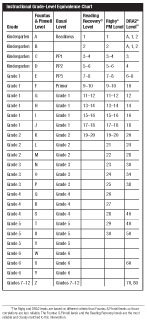Assessment FAQs
A benchmark assessment is a series of texts that can be used to identify a student's current reading level and progress along a gradient of text levels over time. The word "benchmark" means a standard against which to measure something. The Fountas & Pinnell Benchmark Assessment Systems (BAS) evaluate student reading and comprehension ability with reliable and robust universal screening that is aligned to the Leveled Literacy Intervention System, and determine each child's instructional level for guided reading according to the Fountas & Pinnell Text Level Gradient™.
- New Comprehension Conversation Scoring Rubrics. The new rubrics enable more rigorous and consistent administration, analysis, and scoring.
- Revised Comprehension Conversation scoring. We have found that teachers need more guidance on how to conduct the Comprehension Conversation portion of the reading record. To provide this help, we have more clearly defined this process through the creation of a new rubric and have updated the scoring criteria. As a result, there will be more consistency and accuracy in scoring this portion of the assessment. Elimination of the extra point will bring greater consistency of scoring among teachers.
- Updates to the Assessment Guides, Recording Forms, Online Data Management System, and the Benchmark Assessment System Reading Record Apps.
- Enhanced digital delivery and elimination of physical CDs and DVDs. All Recording Forms, Summary Forms, optional assessments, and all NEW Professional Development Videos and Tutorial Videos are now available on Online Resources. In an effort to meet the changing technology landscape, we are eliminating the inclusion of any CDs or DVDs in the system. A unique product code, available on the inside front cover of each Third Edition Assessment Guide, will "unlock" the content in Online Resources.
- All new student and teacher video examples on the Professional Development Videos. Video examples are updated with all new content, including the new prompts and scoring for the comprehension conversation.
- Benchmark Assessment books revised for factual information in nonfiction and other minor changes in fiction and nonfiction.
At the bottom line, when you administer Benchmark Assessment, you are engaging in research. It is important in the process of research to have reliability. In other words, every teacher in your school needs to evaluate comprehension using the same precise criteria. If that is not the case, some teachers will accept superficial responses, while others will apply more rigorous criteria. We need to be rigorous. Otherwise, we will overestimate our students' ability to understand texts, and we will not provide the instruction required.
If students are not deeply understanding the texts, we need to know that, and we need to help them. Assessment should provide this information to help teachers. We felt that teachers needed more guidance on how to conduct the comprehension conversation portion of the reading record. We cannot take for granted students' ability to deeply comprehend texts. It is not enough to read accurately with minimal literal comprehension.
Students are expected to think deeply about texts. To provide this help, Fountas and Pinnell have more clearly defined this process through the creation of a new rubric and have updated the scoring criteria. As a result, there will be more consistency and accuracy in scoring this portion of the assessment. Elimination of the extra point will bring greater consistency of scoring among teachers.
- Scoring has been refined. For example, new criteria for scoring the comprehension conversation has been defined and the extra point has been eliminated.
- Increased rigor in administration and analysis will result in more consistent scoring and determination of students' instructional and independent levels. As a result, assessing students with Benchmark Assessment System, Second Edition may result in slightly higher scores than peers assessed in Benchmark Assessment System, Third Edition.
- It is important to maintain consistency in assessment protocols within schools and districts and continue to assess with Benchmark Assessment System, Second Edition or convert to Benchmark Assessment System, Third Edition. While the more rigorous comprehension scoring will be reflected in the ODMS for Benchmark Assessment System, Third Edition, all student assessment data from all editions will continue to exist within the ODMS.
Instructional Grade-Level Equivalence Chart
Instructional Grade-Level Equivalence Chart

We suggest that you administer the assessment at the beginning of the year to help you determine where to start your teaching with each child. You may also want to conduct the assessment in the middle of the year, to take stock of progress, though you may already have the information from your ongoing use of reading records in instruction. Finally, near the end of the year you may want to conduct one more assessment to obtain a final record of the child's growth across the year. You may decide to administer the last assessment a couple of months before the end of the year. In this case, the assessment can provide information for instruction during the last months of school, while avoiding the redundancy of testing at the very end of one year and the beginning of the next.
At the earliest levels, a full assessment conference may take 20–30 minutes. At the upper levels, where the texts are longer and the conversations more substantive, it may take 30-40 minutes, but as you gain experience, the time will be shorter. Remember that the longer books have a stopping point for oral reading. Also, fluency makes a difference. In this guide, we make several suggestions for how to make efficient use of your time. Remember that each student has had a chance for one-on-one time reading and talking with the teacher.
We provide several time-saving options. If you have no information on a child's previous reading performance, the Where-to-Start Word Test provides a rough starting level for assessment and will cut down the number of books he needs to read before you can identify an independent and an instructional level. If you do have information about a child's previous reading performance and/or know something about the texts he is reading, the Assessment Guides provide correlation charts to help you determine the best starting point.
The precise steps of the assessment conference are described in the Assessment Guides and are systematically presented on the Recording Form for each book. Remember to keep your own language spare and to avoid teaching or leading the student to answers. The introduction to each Benchmark Assessment book is standardized and printed on the cover as well as on the Recording Form. The steps for administration, scoring, and analysis are all standardized and explained in detail in the Assessment Guides. In addition, the tools supporting the assessment, such as the F&P Calculator/ Stopwatch, the Coding and Scoring at-a-Glance chart, and the comprehension conversation rubrics, provide an easy way to maintain consistency across assessments and help you internalize the steps in the process. Furthermore, the Professional Development Videos provide clear examples and plenty of practice opportunities for developing precision and consistency throughout assessment conferences.
We have found that a comprehension conversation is the most effective way to collect the best evidence of comprehension because you can paraphrase questions and probe further for student understanding.
The Assessment Guide provides specific support to help you understand how language differences should be noticed in the administration and interpretation of the assessment. In addition, the Assessment Guide includes case studies of English language learners, providing real-life situations for you to think about and learn from.
Your school or district should make decisions about expected grade-level standards, taking into account your state's goals. You can refer to the Instructional Level Expectations outlined in the Assessment Guide for suggested indicators, but adjust them if you have rationales for a different standard.
There are several approaches to determining a text's level of complexity. Metametrics, the company that provides Lexile measures, takes one approach by measuring text complexity with a proprietary computer algorithm that measures sentence length, syllables, and word frequency.
The levels in the F&P Text Level Gradient™ are based on ten text factors: Genre/Form, Text Structure, Content, Themes and Ideas, Language and Literary Features, Sentence Complexity, Vocabulary, Words, Illustrations, and Book and Print Features. A level obtained from a Benchmark Assessment differs from that obtained with a Lexile assessment in that comprehension is a key factor in the Benchmark Assessment. A student might very well be able to decode high-level texts, but a Benchmark Assessment also determines if the student's comprehension is good enough for instruction.
You will find a variety of tools in the Benchmark Assessment System to support the documentation of a student growth over time, as well as ways to track development of groups and classes. Student folders (included in each system box) provide a longitudinal graph for teachers to record progress. The folders are designed to be passed from teacher to teacher and hold the assessment information on one student from kindergarten to grade 8. The Online Data Management System (ODMS) provides several options for reports on individuals or classes in chart or graph format. The ODMS provides expanded tracking and reporting capabilities for both teachers and administrators in an online format. More information on the ODMS is available on the Heinemann website.
Have regular faculty meetings to examine the data within and across grade levels. Look at the general reading levels of the age cohort, but don't stop there. Use the case studies in Section 5 of the Assessment Guide to help you think about priorities for teaching students. Think across the language and literacy framework. You can teach comprehension through interactive read-aloud, minilessons, guided reading, and literature discussion. The Fountas & Pinnell Literacy Continuum, Expanded Edition (included in your Benchmark Assessment System, Third Edition purchase) can also be used to identify teaching goals.
Yes. The Benchmark Assessment System Reading Record App (RRA) allows teachers to conduct assessments on their iPads instead of using the printed Recording Forms. Use of the RRA requires an in-app purchase. Search for "Fountas and Pinnell" in the Apple iTunes store.
If you did not find an answer to your question in these Frequently Asked Questions, please call or email to ask your question to Fountas and Pinnell Trained Consultants.



